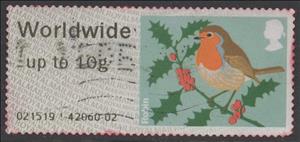Stamp: Robin (Erithacus rubecula) (United Kingdom of Great Britain & Northern Ireland 2010)
Robin (Erithacus rubecula) (United Kingdom of Great Britain & Northern Ireland 2010)
17 September (United Kingdom of Great Britain & Northern Ireland ) within release Post & Go Birds (1st series) goes into circulation Stamp Robin (Erithacus rubecula) face value Worldwide British pound sterling
| Stamp Robin (Erithacus rubecula) in catalogues | |
|---|---|
| Stanley Gibbons: | Sg: GB FS9 IV TIIa |
Stamp is square format.
Type II Code at bottom all numerals and smaller service indicator ranged to the left.Also in the issue Post & Go Birds (1st series):
- Stamp - Blue Tit (Parus caeruleus) face value 1st Class;
- Stamp - European Goldfinch (Carduelis carduelis) face value 1st Class;
- Stamp - Wood Pigeon (Columba palumbus) face value 1st Class;
- Stamp - Wood Pigeon (Columba palumbus) face value 1st Class;
- Stamp - European Robin (Erithacus rubecula) face value 1st Class;
- Stamp - House Sparrow (Passer domesticus) face value 1st Class;
- Stamp - Starling (Sturnus vulgaris) face value 1st Class;
- Stamp - European Robin (Erithacus rubecula) face value 1st Large;
- Stamp - House Sparrow (Passer domesticus) face value 20;
- Stamp - Starling (Sturnus vulgaris) face value Worldwide 10g;
- Stamp - Blue Tit (Parus caeruleus) face value Worldwide 20g;
- Stamp - Robin (Erithacus rubecula) face value Worldwide;
Stamp Robin (Erithacus rubecula) it reflects the thematic directions:
Animals are multicellular, eukaryotic organisms of the kingdom Animalia (also called Metazoa). All animals are motile, meaning they can move spontaneously and independently, at some point in their lives. Their body plan eventually becomes fixed as they develop, although some undergo a process of metamorphosis later on in their lives. All animals are heterotrophs: they must ingest other organisms or their products for sustenance.
Birds (Aves), a subgroup of Reptiles, are the last living examples of Dinosaurs. They are a group of endothermic vertebrates, characterised by feathers, toothless beaked jaws, the laying of hard-shelled eggs, a high metabolic rate, a four-chambered heart, and a strong yet lightweight skeleton. Birds live worldwide and range in size from the 5 cm (2 in) bee hummingbird to the 2.75 m (9 ft) ostrich. They rank as the class of tetrapods with the most living species, at approximately ten thousand, with more than half of these being passerines, sometimes known as perching birds. Birds are the closest living relatives of crocodilians.
Flora is the plant life occurring in a particular region or time, generally the naturally occurring or indigenous—native plant life. The corresponding term for animal life is fauna. Flora, fauna and other forms of life such as fungi are collectively referred to as biota. Sometimes bacteria and fungi are also referred to as flora, as in the terms gut flora or skin flora.



